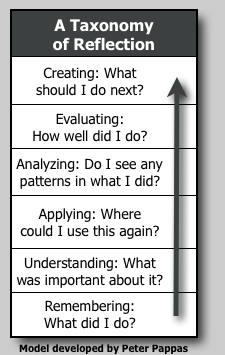
Last week I set the following goals for myself: .... I plan to immerse myself in the content and I would like to accomplish the following:
After class tonight, I realize that I may have made some mistakes in the documentation (i.e. I referred to the course management system as a LMS - sorry Dr. G.) and I have also realized that I need to go back and rework some of the objectives. This phase of the design work is iterative in nature. Reflection and revisions are extremely important to designing the content because the analysis and instructional strategies are key to providing effective instructional content.
Although I understand revisions are necessary and an unavoidable pattern of instructional design, I wish that I did not see as many places for improvement as I do now... This process is one that I will use over and over in future design work, planning professional development, etc. and I recognize that continuous improvement produces quality results.
Overall, I believe that I worked really hard this week. I was productive and provided a lot of feedback to the team. I also feel like we are not quite "there" yet so I know that I need to keep at it. As a team I think we are in agreement about our goals for the project and we seem to have a common vision. I am fortunate to have team mates who let me talk through ideas and we help each other find solutions to problems.
The content analysis is due next week. Over the week I plan to rewrite the performance objectives and try to help Danita with the assessment items. I also want to begin drafting the instructional strategies so that we can all have a clearer picture of the muddy road ahead.
- Identify Tasks and sub-tasks and group by similarity and/or appropriate sequence
- Draft a curriculum map
- Draft performance objectives
- CONTENT ANALYSIS
- Identify tasks for each instructional goal
- Assessment items; each objective w/ key
- Curriculum Map
After class tonight, I realize that I may have made some mistakes in the documentation (i.e. I referred to the course management system as a LMS - sorry Dr. G.) and I have also realized that I need to go back and rework some of the objectives. This phase of the design work is iterative in nature. Reflection and revisions are extremely important to designing the content because the analysis and instructional strategies are key to providing effective instructional content.
Although I understand revisions are necessary and an unavoidable pattern of instructional design, I wish that I did not see as many places for improvement as I do now... This process is one that I will use over and over in future design work, planning professional development, etc. and I recognize that continuous improvement produces quality results.
Overall, I believe that I worked really hard this week. I was productive and provided a lot of feedback to the team. I also feel like we are not quite "there" yet so I know that I need to keep at it. As a team I think we are in agreement about our goals for the project and we seem to have a common vision. I am fortunate to have team mates who let me talk through ideas and we help each other find solutions to problems.
The content analysis is due next week. Over the week I plan to rewrite the performance objectives and try to help Danita with the assessment items. I also want to begin drafting the instructional strategies so that we can all have a clearer picture of the muddy road ahead.



 RSS Feed
RSS Feed
